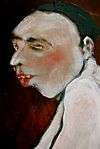Carl Clauberg
| Carl Clauberg | |
|---|---|
| Born |
28 September 1898 Wupperhof, German Empire |
| Died |
9 August 1957 (aged 58) West Germany |
| Allegiance |
|
| Service/branch |
|
Carl Clauberg (28 September 1898 – 9 August 1957) was a German medical doctor who conducted medical experiments on human subjects (mainly Jewish) in Nazi concentration camps during World War II. He worked with Horst Schumann in X-ray sterilization experiments at Auschwitz concentration camp.
Biography

Carl Clauberg was born in 1898 in Wupperhof (now part of Leichlingen), Rhine Province, into a family of craftsmen. During the First World War he served as an infantryman. After the war he studied medicine and eventually reached the rank of chief doctor in the University gynaecological clinic in Kiel. He joined the Nazi party in 1933 and later on was appointed professor of gynaecology at the University of Königsberg. He carried out research on female fertility hormones (particularly progesterone) and their application as infertility treatments, obtaining a Habilitation for this work in 1937.[1] He received the rank of SS-Gruppenführer of the Reserve.
In 1942 he approached Heinrich Himmler (who knew of him through his treatment of the wife of a senior SS officer)[1] and asked him to give him an opportunity to sterilize women in masses for his experiments. Himmler agreed and Clauberg moved to Auschwitz concentration camp in December 1942. Part of the Block number 10 in the main camp became his laboratory. Clauberg looked for an easy and cheap way to sterilize women. He injected formaldehyde preparations into their uteruses—without anesthetics. His test subjects were Jewish and Tzigani women who suffered permanent damage and serious infections. Some of the subjects died because of the tests. Estimates of those who survived but were sterilized are around 700.
When the Red Army approached the camp, Clauberg moved to Ravensbrück concentration camp to continue his experiments on Romani women. Soviet troops captured him there in 1945.
After the war in 1948 Clauberg was put on trial in the Soviet Union and received 25 years in prison. In 1955, he was released (but not pardoned) by the Soviet Union, with the final group of about 10,000 POWs and civilian internees. He returned to West Germany, where he was reinstated at his former clinic based on his prewar scientific output. Bizarre behavior, including openly boasting of his "achievements" in "developing a new sterilization technique at the Auschwitz concentration camp", destroyed any chance he might have had of staying unnoticed. After public outcry from groups of survivors, Clauberg was arrested in 1955 and was put on trial. He died of a heart attack before the trial could start.
Clauberg test
The Clauberg test is an obsolete bioassay to assess progestational activity based on the conversion of proliferative endometrium to secretory endometrium in immature rabbits.[2][3]
See also
References
- 1 2 Robert Jay Lifton, "The Nazi doctors: Medical Killing and the Psychology of Genocide", Basic Books, 2000, ISBN 978-0465049059; pp. 271–278 of the online edition and references there, http://www.holocaust-history.org/lifton/LiftonT271.shtml
- ↑ Clauberg C (1930). "Physiologie und Pathologie der Sexualhormone, im Besonderen des Hormons des Corpus luteum. I. Der biologische Test für das Luteumhormon (das spezielle Hormon des Corpus luteum) am infantilen Kaninchen.". Zentralblatt für Gynänekologie. 54: 2757–2770.
- ↑ "Clauberg's method, alt. Clauberg's test". Whonameit?. Retrieved July 11, 2014.
Bibliography
- Ernst Klee: Auschwitz, die NS-Medizin und ihre Opfer. 3. Auflage. S. Fischer Verlag, Frankfurt am Main, 1997, ISBN 3-596-14906-1.
- Alexander Mitscherlich, Fred Mielke: Medizin ohne Menschlichkeit: Dokumente des Nürnberger Ärzteprozesses, 1. Aufl., Heidelberg: Fischer 1960. ISBN 3-596-22003-3, Taschenbuch wird 2008 in der 16. Auflage vertrieben.
- Jürgen Peter: Der Nürnberger Ärzteprozeß im Spiegel seiner Aufarbeitung anhand der drei Dokumentensammlungen von Alexander Mitscherlich und Fred Mielke. Münster 1994. 2. Auflage 1998.
- Till Bastian: Furchtbare Ärzte. Medizinische Verbrechen im Dritten Reich. Originalausgabe, 3. Auflage, Verlag C. H. Beck, München 2001, Becksche Reihe; Band 1113, ISBN 3-406-44800-3.
- R. J. Lifton, The Nazi Doctors. Medical Killing and the Psychology of Genocide. New York 1986), ISBN 3-608-93121-X.
- Hermann Langbein: Menschen in Auschwitz. Frankfurt am Main, Berlin Wien, Ullstein-Verlag, 1980, ISBN 3-548-33014-2.
- Hans-Joachim Lang: Die Frauen von Block 10. Medizinische Experimente in Auschwitz. Hamburg 2011. ISBN 978-3-455-50222-0.